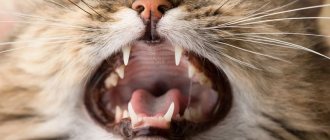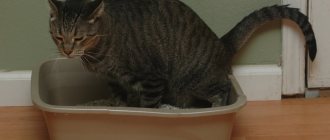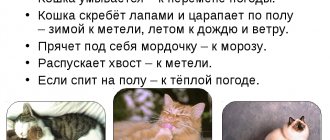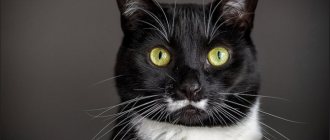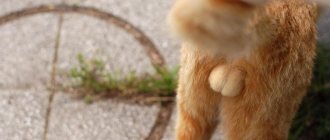What might the stool of a sick animal look like?
In the tray of his pet, the owner may find feces that differ in shape:
- ointment-like;
- mushy;
- liquid;
- foamy;
- in the form of “goat peas”;
- in the form of a tape or pencil.
By smell they distinguish: sour, rancid, putrefactive.
- Feces acquire a sour smell when the absorption of fatty acids in the small intestine is disrupted or due to fermentation processes in the large intestine.
- An unpleasant odor, similar to the smell of bad oil, occurs when the secretory function of the pancreas is disrupted or when the flow of bile is disrupted.
- The smell of rotting occurs when digestion in the stomach is disrupted, dyspepsia develops with the proliferation of putrefactive microflora in the intestines. Or the cat suffers from colitis with ulcerations.
It is customary to distinguish feces by color:
- red (beetroot);
- black (tarry);
- dark brown;
- light brown;
- with a scarlet admixture (undigested blood);
- yellow;
- light yellow;
- greenish yellow;
- bleached slightly yellow, gray, gray-white.
A healthy cat can have red or beetroot feces if it has eaten beets or food colored with bright dyes. This coloring is not pathological and soon the stool acquires a normal color.
Diagnostics
If the owner has noticed that his cat has pooped more than once with feces that are significantly different in color, smell and consistency from the norm, it is necessary to find out the causes of this pathological condition as soon as possible, so a visit to the veterinarian and a comprehensive diagnosis is indispensable. At the first appointment, the doctor will examine the pet, ask the owner what symptoms are bothering his pet and how long the problems with bowel movements have been observed. If it is not possible to immediately establish an accurate diagnosis, a referral is given to such additional research methods as:
- general clinical analysis of blood and urine;
- fecal analysis for the presence of worms, as well as blood, mucous and other inclusions;
- biochemistry;
- Ultrasound of the abdominal organs.
Return to contents
Medicines and dosage for diarrhea in a kitten
There is a list of medications for loose stools tested by veterinarians and cat lovers.
| Medicine | Application |
| Activated carbon | For diarrhea without serious symptoms. If the baby’s condition is good, then one activated carbon will probably be enough as a medicinal component. |
| Smecta | Secures the chair well. It is safe for the baby's health, but the dosage must be observed correctly. |
| Loperamide | Not the very first remedy, since this is a medicinal product aimed at human use. Dosage accuracy is important. |
| Enterosgel | This is also a drug developed for people, but it also turned out to be useful for the cat’s body. Enterosgel is literally an ambulance for getting rid of toxins during diarrhea, infections, and poisoning. It is best to give the medicine at the first symptoms of the disease. |
| Antibiotics | There are various drugs that inhibit the development of the bacterial sphere; glycopeptides are popular groups; aminoglycosides; chloramphenicol. Only a veterinarian can prescribe such a remedy, indicating the dosage and regimen. |
| Enterofuril | The medicine is not given to the cat until 1 month, after which it will seem magical, because diarrhea can go away in a short time. The suspension is recommended for use by kittens as a more moderate remedy for such a small body. |
Causes of changes in stool color
The color of feces, as well as its smell, and consistency change due to errors in the animal’s diet or disturbances in the digestive process, in the movement of the food bolus through the intestines, due to evacuation dysfunction or enzymatic deficiency. For the same reason, a cat's stool may contain large amounts of mucus.
Black-colored feces indicate the presence of blood in the stool that has been enzymatically processed in the stomach. This means that the animal is bleeding from one of the upper parts of the digestive tract (esophagus, stomach). This type of feces is called melena and its appearance is usually accompanied by additional symptoms: a disturbance in the general condition of the animal, weakness, and sometimes vomiting.
Very dark, brown, almost black color of feces occurs in cats due to insufficient digestion of food in the stomach. With the development of pathogenic microflora (putrefactive) in the cat’s intestines, the feces also become very dark. In addition, it acquires an unpleasant specific odor similar to the smell of decaying meat. Stool may be dark if you are constipated. In this case, the consistency becomes dense and looks like a highly structured sausage or individual dense peas. Ulcerative colitis, increased secretory activity of the mucous lining of the large intestine can cause too dark stool.
Light, slightly brown feces occur in animals with increased evacuation function of the large intestine. With the active movement of the food bolus through the intestines, the food is not processed properly. And nutrients are not fully absorbed from it.
An animal's stool may be mixed with fresh blood due to ulcerative colitis, a disintegrating tumor of the lower intestine, or trauma to the lower intestine with a sharp object (a fragment of a chicken bone, a needle or another object swallowed by an animal). A small amount of blood may be present in the stool with anal fissures and bleeding from hemorrhoids. With internal hemorrhoids and spastic colitis, the animal's feces take the form of a ribbon or pencil.
Yellow feces occur in animals on a dairy diet. This color of stool can be due to disruption of digestive processes in the small intestine and the development of dyspepsia associated with fermentation processes. Very light yellow stool occurs when the enzymatic activity of the pancreas is insufficient.
Stool may have greenish impurities due to the presence of bilirubin in it (normally it is absent). Bilirubin enters the stool due to increased peristaltic activity or prolonged use of antibacterial agents and sulfonamides. Suppression of intestinal microflora leads to dysbiosis, although it is believed that cats do not suffer from it. This may be rare in the wild, but eating foods containing antibacterial agents and using such drugs for treatment can lead to serious suppression of the cat's natural intestinal microflora.
Colorless, depigmented or grayish-white feces occur in an animal due to the lack of bile pigments that color it. This occurs when access to the intestines for bile is blocked. A similar situation arises due to infectious diseases of the cat, which cause hepatitis. The reason for the lack of release of bile into the intestines may be mechanical defects (severe spasm of the bile ducts, blockage with a stone), helminthic infestations and organic pathology of the hepatobiliary system (including the growth of tumors). Usually, in this case, the cat’s urine becomes a rich beer color, weakness appears, the quality of the coat deteriorates, and appetite is impaired. Visible mucous membranes, the whites of the eyes and the inside of the cat's ear turn a bright yellow color.
Is a cat whose stool has become light-colored contagious?
Toxoplasmosis, caused by the parasitic protist Toxoplasma, is one of the causes of inflammation of the gallbladder and ducts. For healthy people with good immunity, Toxoplasma poses virtually no threat.
The situation is different for pregnant women or women who become infected on the eve of conception. Parasites can affect the development of the fetus, cause irreversible changes in the development of its internal organs, and provoke miscarriage or stillbirth.
In antenatal clinics, pregnant women are required to undergo testing to detect toxoplasmosis.
Changes in the color of stool may be a consequence of infection with worms, which not only have settled in the intestines, but have also spread throughout the body, including ending up in the liver.
Worms are quickly transmitted from cats to humans, so you need to avoid contact with a sick animal, take special care when cleaning the toilet, and keep children away from it.
Why did my cat's feces change in color?
The factor contributing to this pathology most often is the presence of blood in the stool, but there may be several reasons for this. Bleeding occurs both in the stomach and in different parts of the intestines, which poses a mortal danger to the cat.
This happens in the following cases, each of which requires an individual approach to treatment:
- Worms very often cause this problem. They live in the pet’s intestines, attaching to its walls, thereby violating their integrity. Once in the large intestine, the blood is digested and changes the color of the animal's stool.
- Gastritis or colitis of traumatic origin is an inflammatory process in the stomach or small intestine that is caused by foreign objects. Most often this happens if a cat eats bird bones. When chewed, splintered pieces are obtained that easily injure the internal organs of the animal. Perforations, wounds and microcracks on the walls of organs also appear from other swallowed objects.
- Peptic ulcer of the stomach, duodenum, gastritis and enterocolitis of the same type, all these diseases cause the appearance of bleeding ulcers on the walls of organs, which leads to blackening of the animal’s feces.
- Tumors of the small intestine and stomach, especially malignant ones, lead to ulcers and internal bleeding.
- The hemorrhagic form of gastroenteritis leads to detachment of the epithelium of the mucous membrane of the stomach and some parts of the intestine, injuring small vessels and causing bleeding. This inflammation occurs as a result of complications from severe bacterial and viral infections; the cause may be an autoimmune disease of the animal, severe stress, disturbances in the process of blood clotting, complete intolerance to any food product, food component, or a severe allergic reaction.
Each of the diseases requires urgent and effective treatment. It is impossible to make a diagnosis and select medications on your own.
Treatment at home is only possible if you are completely sure that the pet is suffering from a helminthic infestation. This can only be determined by the presence of parasites in the animal’s feces. But you still can’t do without a consultation and a visit to the veterinarian, since the animal requires not only anti-parasite remedies, but also complex therapy.
Treatment by a veterinarian
Cat owners should immediately realize that it is not white feces, as such, that are being treated, but the cause that led to this condition is being eliminated. The speed of restoration of the color of feces will depend on the severity of the condition and the general condition of the cat’s body at the time of contacting the veterinary clinic. Sometimes it is possible to restore the color of stool within a few days, sometimes treatment will take longer. There are rare cases when the condition may be irreversible (liver block, oncology).
A correct diagnosis can be made based on:
- clinical examination;
- blood tests (biochemistry and general);
- urine and feces examinations;
- Ultrasound;
- x-ray;
- biopsy (usually taken from the liver, but performed quite rarely).
Any therapy will be meaningless without normalizing the cat’s diet or transferring the cat to a special diet recommended by the veterinarian, according to its state of health.
What treatment is used (schedules and course durations are developed only by veterinarians with individual dosage selection):
- hepatoprotectors that normalize liver functions and metabolic processes (thiotriazolin, Essentiale, Hepatovet, Hepatoject);
- choleretic drugs (ursosan, allohol, cholenzyme);
- relieving spasms and biliary-hepatic colic (buscopan, baralgin, papaverine, mebeverine).
No-shpa is highly not recommended for cats due to the high risk of developing unwanted side effects;
What does it mean if a cat has white stool? The cat has white stools and lethargy
Naturally, each case should be considered individually, because many factors can simultaneously have a direct impact on a cat’s stool, which are not always easy to establish without special tests.
The first thing you should do if you suddenly notice a cat has white stool is to try to remember what he ate the day before, because there is a whole group of products that can affect the bowel movement of animals in such a somewhat unusual at first glance way. In fact, everything has a fairly simple explanation and white feces in a cat can easily be caused by an insufficient amount of enzymes, as a result of which individual ingredients (mainly proteins of animal origin) are not completely digested or, in general, pass through the pet’s intestines. For example, a situation where a cat has white stools most often occurs after eating too fatty dense cottage cheese, white meat and fish. Some types of chicken by-products, and in particular necks, are especially difficult to digest.
Interesting situations also occur with combined feeding, when a pet’s stool can be fragmented not only in consistency, but also in color (partially whitish, partially dark brown with clearly defined boundaries). So, this can be explained by the fact that on the same day the fluffy purr ate dry granulated food and natural proteins (dairy, meat or fish products, etc.). In principle, there is nothing terrible or pathological in this, and if the owner no longer wants to observe such external manifestations in his ward, it is enough to simply reconsider his daily diet.
Another fairly common reason why a cat may have white feces is an imbalance in the protein-carbohydrate balance in their body. Such changes are often observed when a pet regularly receives improperly balanced food and its menu is dominated by carbohydrates, while the entire emphasis should be placed on proteins (proteins of animal origin).
Meanwhile, we should not forget that a cat by nature is a predator and even the fluffiest and most harmless purr is in dire need of meat, so you should not deprive it of such a simple pleasure, because it really is of enormous importance for the normal development of the pet.
That is why an abundance of grain crops, as well as vegetable soups, are not included in the normal diet for cats, although, of course, some types of cereals should still be present in it. For example, almost all cats are recommended to be given rice regularly, even in small quantities. Also, for those pets who suffer from chronic constipation, a significant increase in the volume of ingredients containing easily digestible fiber of plant origin (vegetable stews and soups) is provided. At the same time, the presence of animal proteins in the daily menu must, if not be maintained at the same level, then be reduced in small quantities, mainly by increasing the consumption of carbohydrate-containing ingredients.
If, as a result of such an updated diet, the owner suddenly notices that the cat has white feces, but he is still alert and active, then it is advisable to again amend the menu, continuing experiments until the animal’s stool is completely normalized. Things will be completely different if, in parallel with a change in the color of the stool, other negative symptoms are observed, be it lack of appetite, apathy or, on the contrary, unjustified aggression and irritability, lethargy, drowsiness, as well as an increase in general body temperature.
In this case, there is no point in being idle, waiting for everything to work out on its own, because it is more likely to say that the problem is not in the diet at all, but in the functioning of the pet’s internal organs. So, it is quite possible that the liver or gall bladder has suffered a serious malfunction, which most often occurs when there is an excessive concentration of bile or its obstruction into the duodenum. In the latter case, you should additionally observe your pet’s urine, because if it has changed color, then the above assumption is indeed justified.
In addition, it is necessary to pay attention not only to the fact that the cat’s feces are white, but also to its various impurities and inclusions. The fact is that if a cat's white stool contains mucus or blood, then the problems can be much more serious, affecting the entire digestive system of the pet as a whole.
So, if you notice white feces in a cat with all the side symptoms described above, you should immediately show it to a specialist who will examine and palpate the liver, and also prescribe an ultrasound of the internal organs and a biochemical blood test.
Treating a kitten for diarrhea at home
Let's talk about those cases when you can carry out treatment and adjustments at home yourself.
Treatment of newborn kittens
The normal state of the kittens’ body allows the intestines to function as expected, therefore, their feces can be mushy or shaped, yellow or mustard in color. Defecation can be seen up to 4 times a day. From this it follows that diarrhea will be considered liquid, semi-liquid and foamy consistency with a different color palette: black, red, green feces, as well as feces with the presence of gray mucus, helminths and their eggs.
If the cause is a bacterial infection, then you need to take antibiotics, and if the infection is viral, then, accordingly, an antiviral drug.
Worm infestation is treated with anthelmintics, allergies with antihistamines.
What to feed newborn kittens
Symptoms in newborn kittens increase quickly; it is not always possible to immediately seek qualified help - first aid is needed immediately. The cat needs to be given the drug “Smecta” or “Enterosgel”, they will remove toxins.
In case of severe stool upset, you can treat your baby with loperamide at the rate of 0.1 mg per 1 kg of weight.
If there is noticeable dehydration, you need an injection under the withers of Ringer-Locke drug or saline solution. In total, pour no more than 3 ml.
Useful information: How to give an injection to cats
Treatment of a one-month-old kitten
Symptoms of diarrhea in a one-month-old baby will include frequent loose bowel movements with an uncharacteristic odor and color. In the absence of high body temperature or pathological impurities in the stool, you can be treated at home, but otherwise you should take the patient to the doctor.
The first step is to remove from the menu the food that supposedly became the catalyst for diarrhea. You will have to remember what the baby ate in the last days before the illness. Especially if something new was introduced into complementary foods.
global $ads_google; //data-ad-slot=”2475549904″ $ads_google = empty($ads_google) ? false : true; ?> if ($ads_google == false) {?>
$ads_google = true; ?> } ?>
Often, diarrhea at this age is only a reaction to the abrupt weaning of the mother cat with a change to fermented milk food, or cow's milk. Food for adult cats will cause the same reaction.
You should not feed your little cat food from the owner’s table, namely meat, fish, sausage, which is what you usually want to pamper your pet with. At this age this shouldn't happen at all.
What to feed kittens at 1 month
You can make the cat starve for up to 12 hours, and then they begin to feed the rice broth, namely the liquid in which it was boiled. You can give your baby Smecta and Enterosgel, but it is important to follow a diet.
It is important to provide the young body with peace: do not insist on games or frighten it with loud sounds. Stress is not the best help at this time.
Treatment of kittens at 2 months
When a kitten is two months old and suffers from diarrhea, this is often due to a change of place of residence - older cats are given to new owners. But they, in turn, are not very well prepared for such responsibility and have not clarified for themselves all the subtleties of the issues of feeding a pet.
The first thing that should come to mind is stress. For a small cat, this is a change from the familiar world to a new environment, new people, so the body can react in a similar way. It is important to make the new tenant feel that he will be comfortable, calm and happy here.
You can immediately take the baby to a cozy corner, where he himself would begin to master his future possessions. Adaptation will happen faster, diarrhea will be quickly forgotten.
What to give a kitten at two months
If the reasons are more significant, then you can relieve intestinal spasms with papaverine. You also need to thoroughly find out what diet the previous owners followed - if a different diet is planned, then the transition to it should be as smooth as possible.
Diarrhea in three month old kittens
Three-month-old male cats are already bundles of energy and strength, but diarrhea can overtake them too. The reasons may be overeating, eating dangerous substances, or the process of deworming.
Naturally, each body can react in its own way to getting rid of parasites, the main thing is that the loose stools are not prolonged.
Treatment of diarrhea in kittens at 4 and 5 months
When a cat reaches four months, he may already suffer from diarrhea, like his adult counterparts.
Stress can be cited as a cause if:
- a visit to the veterinary hospital took place;
- new pets have settled in the house;
- children showed excessive activity in games;
- there are fears of loud objects and sounds;
- a move to a new place of residence took place;
- it was a long road;
- the menu has changed;
and also if there are diseases of the gastrointestinal tract.
global $ads_google; //data-ad-slot=”2475549904″ $ads_google = empty($ads_google) ? false : true; ?> if ($ads_google == false) {?>
$ads_google = true; ?> } ?>
For 4-5 month old cats, individual treatment is prescribed, but first an examination is carried out to identify significant health-related causes.
Symptoms of helminthiasis
Signs of parasites appearing in an animal’s body can be different. Symptoms directly depend on the type of helminths that have entered the cat’s body and the degree of worm damage.
At the initial stage, the disease does not detect itself, but progresses very quickly, as a result of which the cat becomes weaker day by day.
The main signs of worm infection:
- The animal becomes lethargic and gets tired quickly.
- Small white worms appear in the cat's stool.
- The pet's belly becomes dense and severe bloating can be observed.
- The cat loses its appetite and may refuse food.
- The fur loses its shine and begins to fall out.
- Vomit.
- Problems with passing stool. Constipation alternates with intestinal upset.
- A cat can “ride” on its butt.
- The pet becomes nervous and restless.
What affects the change in the color of stool to white or gray - the reasons for its discoloration
An element called stercobilin is responsible for the color of stool; it is the end product of the breakdown of bilirubin. Stercobilin colors stool brown. Therefore, light-colored feces indicate a lack of stercobilin. You can read more about the process of coloring excrement and the color variations it can take in the article about the color of feces.
Now let's find out what may be associated with a lack of coloring pigment.
White feces as a result of gallbladder dysfunction
One of the most common causes of white stool is blockage of the gallbladder ducts. Stercobilin is a bile pigment and, due to the difficulty of its transportation, feces become discolored, becoming white, gray or clay-colored. Other symptoms may indicate problems with bile transport, the most obvious being yellowing of the eyes and skin. Blockage of the bile ducts can occur due to tumors or the formation of stones. Stones, in turn, are very dangerous, since the bile duct connects to the pancreatic duct, which will lead to disruption of its secretions.
IT IS IMPORTANT TO KNOW!
Gallstones form due to poor nutrition or frequent fasting. The gallbladder requires regular contractions, which occur during meals. When the gallbladder contracts, it releases bile into the intestines to break down fats. During fasting, there is no contraction and, accordingly, no release of bile, which leads to the formation of stones!
When the pancreatic ducts are blocked, its juices will begin to corrode its own tissues, which will further contribute to the leakage of pancreatic juice, which in turn will begin to break down the body from the inside and can be fatal. Therefore, white feces is one of the signs of the need for an urgent medical examination.
Light-colored stool as a symptom of liver dysfunction
The liver plays one of the main roles in digestion. It is in it that bile acids are formed, which then accumulate in the gallbladder. This is not the only process occurring in the liver that causes the stool to change color to gray or white. A lot of different processes and metabolisms of various kinds of substances occur in the liver. In particular, the metabolism of bilirubin, during the breakdown of which the coloring pigment stercobilin is formed. Various types of liver dysfunction can also appear as white feces.
Other causes of white stool in adults
White feces can be caused not only by the reasons described above; the microflora of the intestine itself can affect the change in the color of poop. Light-colored feces occur when bile pigments do not interact properly due to changes in intestinal microflora.
The microflora, in turn, may change for the following reasons:
- Use of any medications that contribute to intestinal dysbiosis. This phenomenon most often occurs while taking antibiotics.
- Perhaps you have recently experienced severe stress, which could contribute to changes in the intestines that cause lightening of the stool.
- A sudden change in diet or poor nutrition also leads to intestinal dysfunction. This is a stressful situation for the body. Therefore, this factor can be attributed to the above. Most often, this factor influences the change in color of stool to gray in children when changing their diet.
The above-mentioned reasons for changes in intestinal microflora most often cause white feces.
If your feces have changed color to white, gray or clayey and this is accompanied by other changes in your body, for example, nausea, sudden changes in temperature, pain in the liver, yellowing of the eyes or skin, then most likely the cause of the white feces is a malfunction liver and gall bladder. In such cases, you should not self-medicate. Problems with these organs can lead to serious consequences, including death. And incorrect self-treatment will only negatively affect the situation and instead of providing treatment, you only finish off your organs. Our body is an integral system, everything in it is interconnected. And if some organ fails, perhaps the source of the problem is in a completely different place. To identify the cause, it is necessary to undergo a series of tests and conduct an examination; this cannot be done at home.
Why is my cat's stool white: urgently go to the clinic
The coloring of feces in a light color does not always indicate errors in nutrition.
There are situations when the breeder must deliver the cat to the RosVet Exhibition Center immediately. The list includes:
- liver pathologies occurring with metabolic disorders and inflammation (hepatitis, hepatosis);
- the pancreas does not provide enough enzymes for digestion;
- developmental anomalies of the gallbladder and its ducts (adhesions, torsion);
- cysts, purulent abscesses;
- cirrhosis of the liver (with pathology, little bile is produced);
- cholangiohepatitis, cholangitis (inflammatory process in the bile ducts and bladder).
You should be alert to some kidney diseases, in which there is an accumulation of toxic products in the body, which then affect the functioning of the liver.
Tumors of various origins in the liver and biliary system can interfere with the normal release of bile into the intestines. The absence of bladder contractions (atony) completely stops the flow of bile into the gastrointestinal tract, and there is a risk of rupture and peritonitis.
What to do for prevention?
Liquid or dry feces, which are constantly observed in a pet, in any case, are evidence of some kind of internal progressive disorder. To prevent consequences dangerous to the cat’s health and life, it is important to follow preventive rules. First of all, it is important to monitor the cat’s nutrition and provide it with fresh and clean water. Do not forget to carry out preventive anthelmintic treatment.
If viral infectious diseases develop, do not self-medicate, but take the animal to a veterinarian, who, based on the diagnostic results, will select an effective treatment. In order for the cat’s body to more actively resist various diseases, it is useful to strengthen the pet’s immunity. To do this, it is recommended to give courses of vitamins and various biologically active supplements, which are selected by the veterinarian, taking into account the individual characteristics of the cat.
Causes of light-colored stool in pregnant women and children
Before a child can be born, it must be conceived and then carried to term. So let's start with pregnant women first and then move on to children.
In pregnant women, gray feces can be observed due to the consumption of large amounts of fruits and all kinds of vitamin complexes. A child needs a lot of vitamins. If this is not accompanied by abdominal pain and other types of ailments, then most likely there is no cause for concern. When changing the diet, the color of feces should normalize. But it is better to consult a doctor.
Newborn babies may also experience abnormal stool color. Infants' poop may contain white specks. These inclusions are nothing more than lumps of fat from the mother's breast milk. Also, when fed heavily with formula milk, baby shit can take on a light color. Diet adjustments are necessary to normalize the color of the newborn's stool. But do not lose your vigilance, carefully monitor your child’s behavior and possible changes in mood; perhaps something hurts him. In this case, the cause of light-colored poop is no longer food, but something else. In any case, it is better to play it safe and consult your pediatrician.
So the couple came to take stock. Know that you need to regularly check what you got there when you go to the toilet for the most part. What if there is a message or distress signal there for you? In some cases, changes noticed in time will play a significant role in treatment. Be attentive to all changes in your body; it has its own alphabet to communicate with you, and sometimes its letters are poop.
And remember, a site about poop will always be happy to help you in any life situation. We wish you healthy feces and excellent digestion and appetite!
Relief!
What do worm eggs look like?
Let's say you find something that looks like worms in your pet's stool, what should you do next? First, you need to understand what you see. Fecal matter may contain live and dead parasites, their eggs, incompletely digested food, and inedible objects that the cat swallowed accidentally or intentionally.
The range of parasites that a cat can become infected with amounts to hundreds of species. Each parasite belongs to a specific family, subfamily or species. Each type of worm has similar features: color, length, body shape, shape and color of eggs. First, let's figure out what worm eggs look like, which you can distinguish visually.
White round spots in stool - what is it?
Almost all worms that parasitize the body of cats are very modest in size and have microscopic eggs that are invisible to the human eye. The exception is tapeworms, which are also called tapeworms and tapeworms.
The body of these parasites consists of:
- Heads with oral apparatus, several rows of hooks and/or suckers.
- Segments (segments) that form a long body.
- This is incredible! Depending on the type of worm, its body can consist of 4–200 segments. Each segment is a vessel for 1–800 eggs, which must be released into the external environment.
The most common tapeworm that affects cats is the cucumber tapeworm (often called borage). Parasite eggs can be identified by visual signs:
- Round with slightly pointed tips, similar to sesame or cucumber seeds.
- White, slightly transparent.
- The main distinguishing feature is that the eggs move and move due to the flat muscles of the segment.
Tapeworm eggs are most often found:
- In feces.
- On the pet's bedding.
- On the fur around the anus.
The life cycle of borage has its own peculiarities. Each worm is hermaphrodite, meaning it reproduces and fertilizes its own eggs. The egg, released into the external environment, begins to move to find a temporary carrier. The egg is eaten by a flea (flea eater), which becomes a vessel for the maturation of the egg.
When the parasite is ready to molt, it hibernates and waits for the right conditions. A flea living on a cat gets caught in the pet's teeth when it tries to relieve the itching. The swallowed flea is digested, and the egg sheds as soon as it enters the intestines.
Once in a suitable habitat, the head of the parasite is implanted into the intestinal mucosa, in other words, it digs into it with hooks and begins to drink blood. Within 30–40 days, the worm matures and becomes sexually mature. Afterwards, the helminth begins to form segments, each of which contains a fertilized egg. The last segment (the tail of the worm) breaks off and comes out with the feces as soon as the egg is ready to “move” into the body of a temporary carrier.
Your cat is constipated or changes in stool color
14054 views
Lack of bowel movements is always a sign that your pet is unhealthy. The norm is considered to be at least one bowel movement per day.
If the act of defecation occurs untimely and with long delays, this can lead to intoxication of the animal and other serious negative consequences. If you notice that the cat does not go to the toilet or meows and makes other sounds when defecating, spends a lot of time on this process, but often without results, if the feces are dry and the amount is small, you can talk about constipation in the cat. Constipation can be caused by an unbalanced diet, low protein food, dehydration, or the formation of hairballs in the esophagus. In cases of constipation and complicated bowel movements of your pet, you must contact your veterinarian and take the prescribed treatment.
A change in the color of stool may indicate problems of various origins. The normal color of feces is brown. When the color is normal, but the stool is loose, this can be caused by eating poor quality, stale food, as well as infection by parasites. But what if the stool is an unusual color?
If the stool turns black, this may indicate the presence of digested blood, which indicates internal bleeding in the upper digestive tract.
If blood is found in the stool in the state in which everyone is accustomed to seeing it, scarlet or bright red, it means that the blood has not been digested and bleeding is taking place in the lower parts of the digestive tract. In any case, the presence of bleeding in any part of the digestive tract should not be ignored and prompt assistance from a veterinarian.
If your pet's stool has acquired a greenish or yellowish tint, this may indicate problems with digestion of food, dysbiosis and other digestive disorders. If the stool is completely light yellow or even beige, white, this is an indication of a malfunction of the liver.
Grayish feces indicate problems with digesting the food you eat. If the feces are oily or watery, this may indicate failures in the absorption of excess fluid by the intestinal walls.
If any of the listed manifestations of changes in the quality, quantity, or consistency of your cat’s stool occur, you should immediately contact your veterinarian, take stool tests, and, having received the results and referrals from a specialist, begin treatment.
It is strictly not recommended to start treatment with human drugs and dosages on your own, as this can aggravate the animal’s condition and precious time will be lost.
Useful materials:
- Cutaneous horn General description of the disease Cutaneous horn on the forehead or face (ICD 10 code - L57.0) -...
- Cloudy eye in a cat Common causes of cloudy eyes in a cat The most common causes of cloudy eyes are glaucoma, cataracts or keratitis.…
- Itching and odorless discharge Main causesBefore considering the factors that provoke the appearance of discharge that has a sour odor, it is necessary to immediately note...
- Normal temperature in animals Normal temperature in different types of animals Veterinary services Day hospital for animals Veterinary certificates Vaccination…
Symptoms of diarrhea in kittens
global $ads_google; //data-ad-slot=”2475549904″ $ads_google = empty($ads_google) ? false : true; ?> if ($ads_google == false) {?>
$ads_google = true; ?> } ?>
It is not difficult to determine that a kitten has diarrhea. This is necessary in order to take health measures in a timely manner and prevent serious consequences for the life of the young cat.
So, we determine loose stools in kittens:
- the kitten’s state can easily be considered depressed;
- there are problems with appetite, more often it simply doesn’t exist;
- if diarrhea is prolonged, the animal’s weight will decrease;
- frequent bowel movements;
- dehydration (when taken by the scruff of the neck, the skin then straightens out for a long time);
- loose stools, possible admixtures of undigested food;
- your tummy may be bloated.
In general, it is clear from the baby that he is experiencing discomfort, so it is important to find out what could cause such a disruption of the gastrointestinal tract.
About your pets' excrement
In this article we will talk about a sensitive topic. about your pets' excrement, aka feces.
Any encyclopedia will tell you - feces (faeces; synonyms: feces, excrement) - the contents of the distal part of the large intestine, released during defecation.
Normally, cats have bowel movements once or twice a day, the stool is formed, slightly moist and soft, dark brown in color, there is no mucus, blood or undigested food in it. Ideally, the size of the stool should be significantly smaller than the amount of food on the plate (25%). When there is less output than input, the cat extracts more nutrients from the food. Large stools are caused by the presence of undigested filler in feed such as corn and other plant products.
If the diarrhea is black
global $ads_google;
//data-ad-slot=”2475549904″ $ads_google = empty($ads_google) ? false : true; ?> if ($ads_google == false) {?> $ads_google = true; ?> } ?> Mustard-colored liquid feces in kittens is normal, but the black color called “melena” is not at all present. This is evidence of problems in the body, unless, of course, there are preparations containing iron in the diet, or there is an excessive amount of raw meat or blood meal.
The list of diseases associated with red-black diarrhea is long; you cannot cope with this on your own; consult a doctor.
